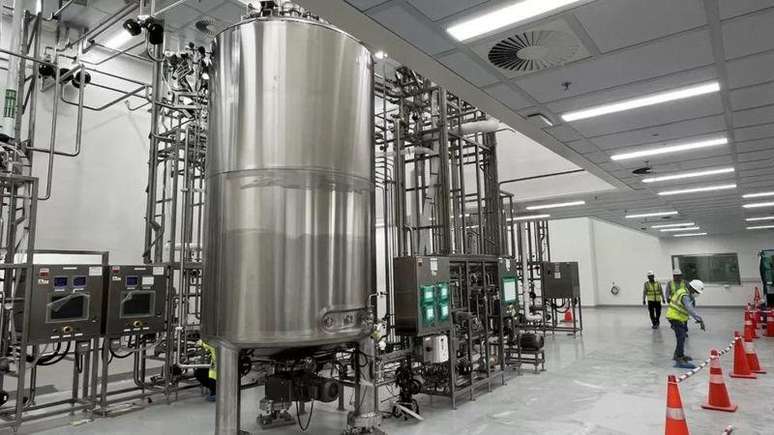So far, only Eat Just has managed to get its product approved for public sale in Singapore.
html[data-range=”xlarge”] figure image img.img-28acc93df00f3f91ff3077d175b50392w3mq7onl { width: 774px; height: 435px; }HTML[data-range=”large”] figure image img.img-28acc93df00f3f91ff3077d175b50392w3mq7onl { width: 548px; height: 308px; }HTML[data-range=”small”] figure image img.img-28acc93df00f3f91ff3077d175b50392w3mq7onl, html[data-range=”medium”] figure image img.img-28acc93df00f3f91ff3077d175b50392w3mq7onl { width: 564px; height: 317px; }
Looks like chicken, smells like chicken and tastes like chicken.
I never imagined that the piece of meat in front of me didn’t come from a farm. But it was made in a workshop in an industrial area a few miles away.
I’m at Huber’s Butchery and Bistro in Singapore, the only restaurant in the world that offers what it calls “culture meat” on the menu.
Customer response has been “phenomenal,” according to the restaurant owner.
The creator of the meat, the Californian company Eat Just, guarantees that its product manages to be ethical, clean and ecological, without sacrificing flavour.
Billions of dollars are invested in this area, but there are big questions about its long-term viability.
Since the first lab-grown burger was unveiled in London in 2013, a creation that cost a staggering $330,000 (R$1.8 million), dozens of companies around the world have joined the race to market lab-grown meat at reasonable prices.
So far only Eat Just has managed to get its product approved for sale to the public after regulators in Singapore, the only country in the world that allows the sale of this type of meat, gave the green light to its chicken in December 2020.
But the product is far from being mass-produced.

Lab-grown chicken nuggets were briefly on a private club menu in 2021.
That partnership lasted a few months, and this year, Huber’s began offering a chicken sandwich and chicken noodle dish to the general public, albeit only once a week.
“Cultivated meat is real meat, but you don’t have to slaughter an animal,” said Josh Tetrick, chief executive of Eat Just, who spoke to the BBC from San Francisco. “This way of eating makes sense for the future.”
Unlike plant substitutes, cultured meat is literally meat. The process involves extracting cells from an animal, which are fed nutrients such as proteins, sugars and fats.
The cells can then divide and grow, before being placed in a large steel bioreactor, which doubles as a fermentation tank.
After 4-6 weeks, the material is “harvested” from the bioreactor and some plant protein is added. It is then shaped, fired and 3D printed to achieve the required shape and texture.
Fried chicken strips in my plate with noodles orecchiette they definitely tasted like regular chicken, albeit a bit processed.
Maybe the kind of chicken you’d get in a fancy restaurant. fast food.
“It’s meat, it’s perfect!” said Caterina, an Italian student who came here specifically to try the lab-raised chicken.
Normally, for reasons of sustainability, I would not eat meat, but Caterina assured me that I would.
Your only objection? Chicken is served with pasta, which is not often the case in Italy.
Another customer in Singapore said he was surprised that the lab chicken tasted so much like real meat.
“It’s legit,” he said. “I wouldn’t know where it came from. My only concern would be the cost.”
The chicken noodle dish I ordered cost US$13.70 (R$65.91 at current prices), but that’s a big discount compared to the cost of producing this meat.
Eat Just doesn’t say exactly how much it spends producing its chicken, but the company’s production capacity is currently 3kg a week in Singapore.
When you compare that to the 4,000-5,000kg of conventional chicken sold weekly by Huber alone, you get an idea of the scale of the task facing the company.
Simply put, they will have to significantly increase production to avoid losses on every portion of chicken.

Eat Just notes that it has already achieved a 90% cost reduction since 2018. The company took me to a tours for its new multimillion-dollar manufacturing facility in Singapore, which it plans to open in 2024.
The pair of 6,000-liter polished steel bioreactors is certainly a sign that the intent is there, but it’s a small fraction of the millions of tons of chicken that need to be produced to match the current price of traditional chicken.
Industry begs for patience, but many scientists say they’ve seen enough.
“The narrative presented by these companies is very strong,” said Ricardo San Martín, co-director of the Alt:Meat Lab at the University of California (UC) Berkeley.
“But you have to contrast that talk with science,” he added. “Do the math, look at every scientific article written by independent experts, and you’ll see that the answer is clear.”
“Can you do it, on a large scale, at a reasonable cost? No. Can you talk about saving the world with that? Again, no. These companies need to be honest. This is wishful thinking.”
There is only doubt about the possibility of increasing production. There is also uncertainty about the sector’s green credentials, which have been questioned by scientists.
In theory, reducing dependence on land and livestock for meat production should reduce carbon emissions. But for now, the technology required to create lab-grown meat requires so much energy that it negates any benefit.
A study from the University of California at Davis even estimated that the process produces 4 to 25 times more carbon dioxide than regular meat. However, East Just calls this study “problematic.”
When asked by the BBC whether the whole project could fail, Eat Just’s Josh Tetrickz replied: “Of course”.
“Making meat this way is necessary and very uncertain,” he said.
“It’s not easy. It’s complicated. It’s not guaranteed and it might not work. But the other option for us would be to do nothing. So we decided to take a gamble and give it a try.”
Many investors have decided to make the same bet. An estimated US$2.8 billion (R$13.47 billion) has been invested in the development of laboratory meat this year.
However, the attempt to make artificially grown meat more than a niche alternative for the wealthy in the developed world will depend on the investment of private companies. And it may not be enough.
Governments, Tetrick noted, will need to invest “a significant amount of public money” in lab-grown meat if they are to compete with conventional meat.
“It’s like switching to renewable energy… It’s a lifetime project, maybe a lifetime project,” he said.
So far, no country other than Singapore has allowed the sale of artificially grown meat, let alone major investments.
According to Ricardo San Martín of UC Berkeley, public and private funding for laboratory meat companies will dry up if these companies don’t “look in the mirror” soon and present realistic forecasts to investors.
“Unless there is a clear path to success in the future, investors and governments won’t want to spend money on something that isn’t scientifically proven.”
– This text was published at https://www.bbc.com/portuguese/articles/cxxerjx6zg8o
Source: Terra
Ben Stock is a lifestyle journalist and author at Gossipify. He writes about topics such as health, wellness, travel, food and home decor. He provides practical advice and inspiration to improve well-being, keeps readers up to date with latest lifestyle news and trends, known for his engaging writing style, in-depth analysis and unique perspectives.









